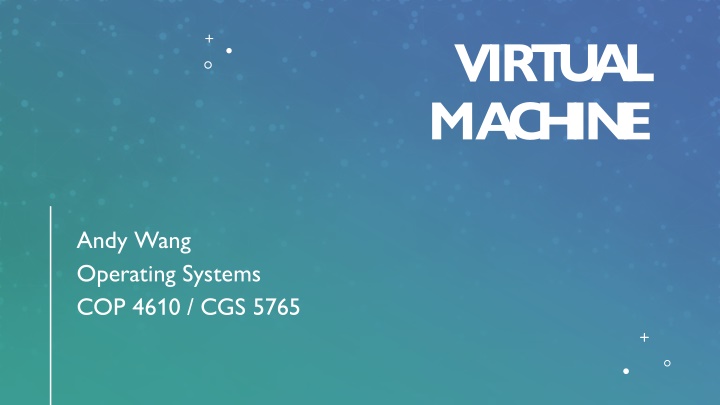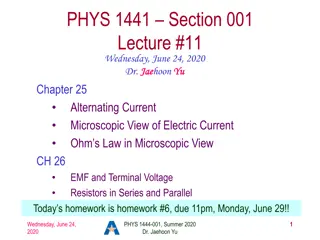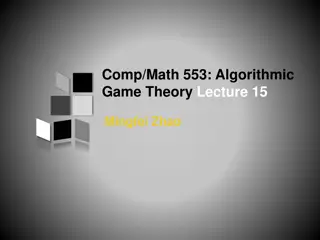
Virtual Machine Overview and Types
Explore the concept of virtual machines, how they abstract hardware into different environments, and the different types of virtual machine hypervisors. Learn about the history, goals, and intricacies of virtualization technology. Discover various virtualization schemes and their impact on modern computing.
Download Presentation

Please find below an Image/Link to download the presentation.
The content on the website is provided AS IS for your information and personal use only. It may not be sold, licensed, or shared on other websites without obtaining consent from the author. If you encounter any issues during the download, it is possible that the publisher has removed the file from their server.
You are allowed to download the files provided on this website for personal or commercial use, subject to the condition that they are used lawfully. All files are the property of their respective owners.
The content on the website is provided AS IS for your information and personal use only. It may not be sold, licensed, or shared on other websites without obtaining consent from the author.
E N D
Presentation Transcript
VIRT UAL MAC HINE Andy Wang Operating Systems COP 4610 / CGS 5765
Overview A virtual machine (VM) abstracts HW into different execution environments Provides the illusion that each VM has its own private computer Recall that an OS is a VM VM components Host: underlying HW that runs VM Virtual machine manager (VMM), a.k.a. hypervisor provides an interface identical to HW Guestprocesses: contain a virtual copies of the host running different OSes
Conceptual Overview programming interface processes processes processes processes kernel kernel kernel VM VM VM kernel Virtual machine manager (VMM) hardware hardware Single machine running 3 VMs Single OS machine
Virtual Machine Types Type 0 hypervisors HW-based solutions that support VMs E.g., IBM LPARs Type 1 hypervisors OS-like software to provide virtualization, runs on HW w/o OS E.g., VMWare ESXi, KVM Type 2 hypervisors Applications running on OS with VMM features E.g., VMWare Workstation
Other Virtualization Schemes Paravirtualization Exploits modern HW support to optimize performance E.g., Xen Programming environment virtualization Programs compiled into HW- specific binaries on the fly E.g., Java, Microsoft.Net Emulators Applications written for one HW can run on a different HW Application containment OS provides virtualized devices for applications E.g., dockers
Brief History First introduced by IBM mainframes in 1972, IBM VM OS IBM VM/370 allowed multiple VMs running its own OS Major challenge How to virtualize disks? Suppose you have 3 disks shared by 7 virtual machines . Sure, we can partition disks to provide virtual disks Each running its own elevator algorithm Serious performance implications A RAID assumes each physical disk fails independently . Multiple virtual disks can reside on the same physical disk Not to mention performance interference among virtual disks
Early Goals of VM Fidelity Can run unaltered applications with the same behavior Performance Only minor performance degradation if possible Safety VMM controls all resources
After 1990s PCs became common and CPU cycles became cheaply available Xen, VMWare, Virtual Box VMs can run on different HWs (Intel, AMD) Support different Oses (Windows, Linux, macOS, BSD, etc.)
Benefits and Features of Virtualization Resource isolation (better security) + Host is protected from VMs; VMs are protected from each other A virus in a guest OS is unlikely to affect the host or other guests - Prevents sharing of resources and layer-crossing overhead Host has a windows manager buffer; guest has another windows manager buffer Mouse cursor can become laggy Need to integrate display buffers across layers A file system can be mounted across different VMs Define a network of VMs to communicate via a virtual network
Benefits and Features of Virtualization (2) Snapshot A VM can be resumed from a snapshot An OS can be reset to a snapshot when failed (for debugging OS) Faster than rebooting A VM can be cloned to provide an environment template GitHub Classroom Multiple people can work on the same bug in separate VMs Easier to administer (e.g., updating) 100 VM images than 100 servers A snapshot can be migrated to another machine Consolidate VMs on fewer machines and power down unused machines Can reduce the number of per-server software licenses Commonly used in cloud computing
VM Building Blocks Trap and emulate When a guest VM executes a privileged instruction (mostly IOs) Causes an error (wrong mode) and cause a trap to VMM VMM emulates the HW Nonprivileged VM instructions run on raw HW Modern CPUs provide extra modes beyond just dual modes to support VMs processes processes processes kernel kernel kernel VM VM VM Virtual machine manager (VMM) hardware
Hardware Support (Simplified VMM) Modern CPUs support virtualization Supports host (root) and guest (non-root) modes HW supported host and guest page tables HW supported DMAs DMA memory regions are shared by all guests DMA tracks which memory regions belong to each guest Interrupt remapping to individual guests
Type 0 Hypervisor (a.k.a Domains) VMM are encoded in firmware (hardware embedded software), loaded at boot time Partitioned HW resources for each guest OS Each guest OS can also run its own guest OSes (nesting, only for Type 0 hypervisors) guest 2 guest 1 guest guest guest VMM firmware hardware
Type 1 Hypervisor (a.k.a. Data Center OS) Commonly used in data centers Can run natively on HW (kernel mode) Create, run, and manage guest OSes (multiple modes) Provides device drivers, CPU scheduling, memory management, I/O management, protection, security E.g., VMWare ESXi (closed source), Xen (open source) + load consolidation + ease of creating more instances - license cost, mostly closed source Apps Apps Apps OS OS OS VMM hardware
Type 2 Hypervisor Little OS involvement in application-level VMM VMM is just another process managed by the host Host is not aware of the virtualization within the VMM process E.g., VMWare WorkStation Implications + Can run VMs without changes in the host OS - Poor performance due to the lack of OS support Apps Apps Apps OS OS VMM OS hardware
Paravirtualization Presents a guest system a similar but not identical host system (e.g., Xen) Goal: exploit HW support for more efficient use of resources Example optimizations Instead of having one device queue per guest Shared circular buffer for all guests Instead of nested page tables Guests make hypercalls to VMM to update its page table entries
Programming Environment Virtualization A programming language is designed to run within a virtual environment Example: JVM JVM is compiled to be a native program for a particular HW Java programs run within the JVM running on different HWs Another example: interpreters E.g., JavaScript, Python Each program instruction is interpreted into the native operations
Emulation Needed when the host has one system architecture (x86), and the guest system is compiled for a different architecture (ARM64) Needed for backward compatibility to run legacy software E.g., vintage video games Performance may be an issue; however, newer computers tend to be faster
Application Containment Suppose all applications are compiled for the same HW A container virtualizes OS and devices E.g., docker, Linux LXC via the clone() system call Each contains applications, necessary libraries, network stacks, network address and ports, etc. + lighter weight then virtualizing HW
Example Containers Solaris Zones Dockers global zone app 2 app 1 app 3 app zone work zone users zone docker host OS hardware zone management with virtual devices hardware
Virtualization and OS Components CPU scheduling Memory management I/O Storage management
CPU Scheduling VMM presents 1+ virtual CPUs to each VM VMM itself also needs CPUs Can divide CPUs equally among VMs, or based on some pricing policies Each VM can have dedicated CPUs Each guest OS can act independently VMs can also share a CPU - Poor responsiveness (e.g., mouse cursor) - Inaccurate time accounting (clocks are off)
Memory Management Each VM needs to state maximum memory to be used VMM memory management approaches Double paging VMM pages memory in before remapping them into guest VM VMM has its own page-replacement policy Not efficient VMs tell VMM to allocate/deallocate pinned memory Pinned memory cannot be paged out VMM hashes page content If two VMs share the same page content (e.g., OS code, Chrome), don t cache duplicate pages
I/O Device management schemes Dedicated devices (best performance) Device sharing Storage Need to make sure that each VM can only access their own storage blocks VMM needs to check each access Network Each guest needs to have an IP address VMM server needs to have dozens of addresses VMM needs to perform routing, provide firewalls between guests and external systems Direct network connection (bridged networking) VMM can provide network address translation (NAT)
Storage Management With multiple VMs, where is the boot partition? Can t provide hundreds of boot partitions Type 0 hypervisors tend to use root partitioning Tend to have fewer guests than other types of hypervisors Type 1 hypervisors stores the guest root disk in 1+ files Type 2 hypervisors stores the info in the host s file system as a VM image
Migration Useful to move system loads Manage electricity CPU clock speed doubles, power quadruples By spreading out the loads, data centers can clock down CPUs to save power Offline migration steps Halting the guest Copying the VM image to another VMM Resume VM
Live Migration Steps 1. Source VMM connects with the target VMM 2. Target creates a new guest, new virtual CPU, new nested page table, and other state storage 3. Source sends read-only memory pages to target 4. Source sends all red-write pages to target, marks them as clean 5. Repeat step 4, until steps 4 and 5 become very short 6. Freeze source guest, sends virtual CPU s final states, and dirty pages, and start the target guest. End source guest.
Limitations of Live Migration No storage state is transferred (too expensive) The target guest memory has file open table, system call states (file seek offset), kernel state, etc. Storage is accessed via network
VM Research Performance optimizations VM placement in data centers Applications of AI to optimize VM servers Performance isolation QoS guarantees






















